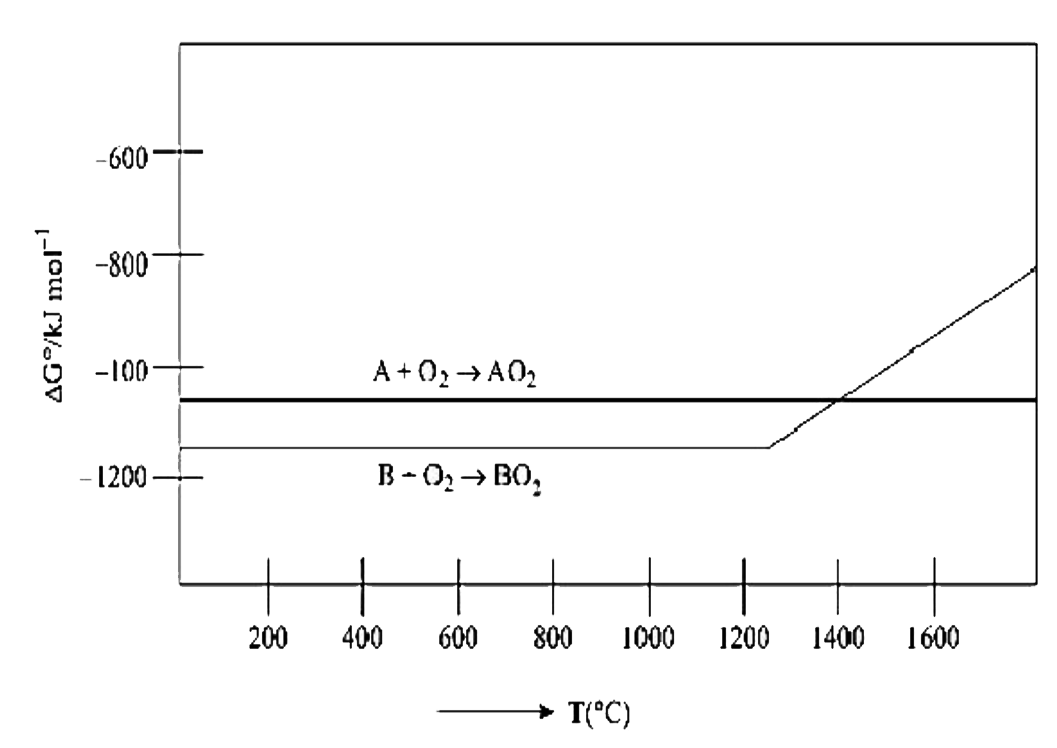According to Ellingham diagram the oxidation reaction of carbon and carbon monoxide may be used to reduce which one of the following oxides at the lowest temperature?
Al2O3
CuO
MgO
ZnO
The correct Answer is:B, D
To solve the question regarding which oxide can be reduced by carbon or carbon monoxide at the lowest temperature according to the Ellingham diagram, we can follow these steps:
Step 1: Understand the Ellingham Diagram
The Ellingham diagram is a graphical representation that shows the stability of various oxides and the temperature at which they can be reduced. The lower the line on the diagram, the more stable the oxide is at that temperature.
Step 2: Analyze Each Oxide
We need to analyze the four given oxides (Al2O3, CuO, MgO, ZnO) in relation to carbon (C) and carbon monoxide (CO) based on their positions in the Ellingham diagram.
Step 3: Check Al2O3
- The line for Al2O3 is around -1050°C.
- The line for C is around -450°C.
- Since C is above Al2O3 on the diagram, carbon cannot reduce Al2O3.
Step 4: Check CuO
- The line for CuO is above C.
- The reaction can be represented as CuO + C → Cu + CO2.
- Since C is below CuO on the diagram, carbon can reduce CuO.
Step 5: Check MgO
- The line for MgO is lower than CO.
- The reaction can be represented as Mg + CO → MgO + C.
- Since CO is above MgO, carbon monoxide cannot reduce MgO.
Step 6: Check ZnO
- The line for ZnO is around -650°C.
- The reaction can be represented as Zn + CO → ZnO + C.
- Since CO is above ZnO, carbon monoxide cannot reduce ZnO.
Conclusion
Based on the analysis, the only oxide that can be reduced by carbon at the lowest temperature is CuO. Therefore, the correct answer is CuO.
Final Answer
CuO
---
The Ellingham diagram is a graphical representation that shows the stability of various oxides and the temperature at which they can be reduced. The lower the line on the diagram, the more stable the oxide is at that temperature.
We need to analyze the four given oxides (Al2O3, CuO, MgO, ZnO) in relation to carbon (C) and carbon monoxide (CO) based on their positions in the Ellingham diagram.
- The line for Al2O3 is around -1050°C.
- The line for C is around -450°C.
- Since C is above Al2O3 on the diagram, carbon cannot reduce Al2O3.
- The line for CuO is above C.
- The reaction can be represented as CuO + C → Cu + CO2.
- Since C is below CuO on the diagram, carbon can reduce CuO.
- The line for MgO is lower than CO.
- The reaction can be represented as Mg + CO → MgO + C.
- Since CO is above MgO, carbon monoxide cannot reduce MgO.
- The line for ZnO is around -650°C.
- The reaction can be represented as Zn + CO → ZnO + C.
- Since CO is above ZnO, carbon monoxide cannot reduce ZnO.
Based on the analysis, the only oxide that can be reduced by carbon at the lowest temperature is CuO. Therefore, the correct answer is CuO.
CuO
Topper's Solved these Questions
- GENERAL PRINCIPLES AND PROCESS OF ISOLATION OF ELEMENTSBOOK - CENGAGE CHEMISTRY ENGLISHCHAPTER - GENERAL PRINCIPLES AND PROCESS OF ISOLATION OF ELEMENTSEXERCISE - Exercise (Single Correcttype)
106 Videos
- GENERAL PRINCIPLES AND PROCESS OF ISOLATION OF ELEMENTSBOOK - CENGAGE CHEMISTRY ENGLISHCHAPTER - GENERAL PRINCIPLES AND PROCESS OF ISOLATION OF ELEMENTSEXERCISE - Exercise (Assertion-Reasoning)
18 Videos
- GENERAL PRINCIPLES AND PROCESS OF ISOLATION OF ELEMENTSBOOK - CENGAGE CHEMISTRY ENGLISHCHAPTER - GENERAL PRINCIPLES AND PROCESS OF ISOLATION OF ELEMENTSEXERCISE - Exercises (Linked Comprehension)
42 Videos
- ELECTROCHEMISTRYBOOK - CENGAGE CHEMISTRY ENGLISHCHAPTER - ELECTROCHEMISTRYEXERCISE - Archieves Subjective
35 Videos
- GRIGNARD REAGENTS AND ORGANOMETALLIC REAGENTSBOOK - CENGAGE CHEMISTRY ENGLISHCHAPTER - GRIGNARD REAGENTS AND ORGANOMETALLIC REAGENTSEXERCISE - Exercises Archives (Linked Comprehension)
1 Video
Similar Questions
Carbon and CO gas are used to reduce which of the following pairs of metal oxides for extraction of metals ?
View SolutionWhich of the following has lowest percentage of carbon?
View SolutionExplain the reducing action of carbon mono oxide.
View SolutionWhich of the following has the lowest percentage of carbon in it?
View SolutionDraw the Ellingham diagram for the formation of carbon monoxide. What happens to the stability of carbon monoxide with the increase in temperature ?
View SolutionWhich of the following is not correct about carbon monoxide?
View SolutionAccording to the following diagram, A reduces BO2 When the temperature is

View SolutionWhich of the following is not a reducing oxide ?
View SolutionAccording to the following diagram, A reduces BO2 when the temperature is:

View SolutionIn Which of the following compunds the metal is in the lowest oxidation state?
View Solution